About this blog: One of the most rewarding aspects of travelling for us is that we get to meet various people. And while we meet them, we are introduced to a whole new world of delightful people, traditions, interesting rituals and customs. As a cultural travel blogger, I had asked my fellow travel bloggers about fascinating traditions and customs and most unique and interesting cultures around the world that they had come across.
I always believe that travelling opens up new horizons. As travellers, we get to realize the vastness and diversity of the world. We are out of our comfort zone and also happen to appreciate the little joys of life. After about 15 years of travelling through different parts of India and around, we have visited some incredible places and explored some remote destinations. However, the favourite part of our adventure on the road has always been meeting new people and learning about new cultures. Agni and I love to document the places and the people, culture and traditions that are unique, vanishing and are changing with time.
Here are some of the interesting cultures around the world as suggested by my travel blogger friends. This blog contains some of the interesting customs and traditions of the people.
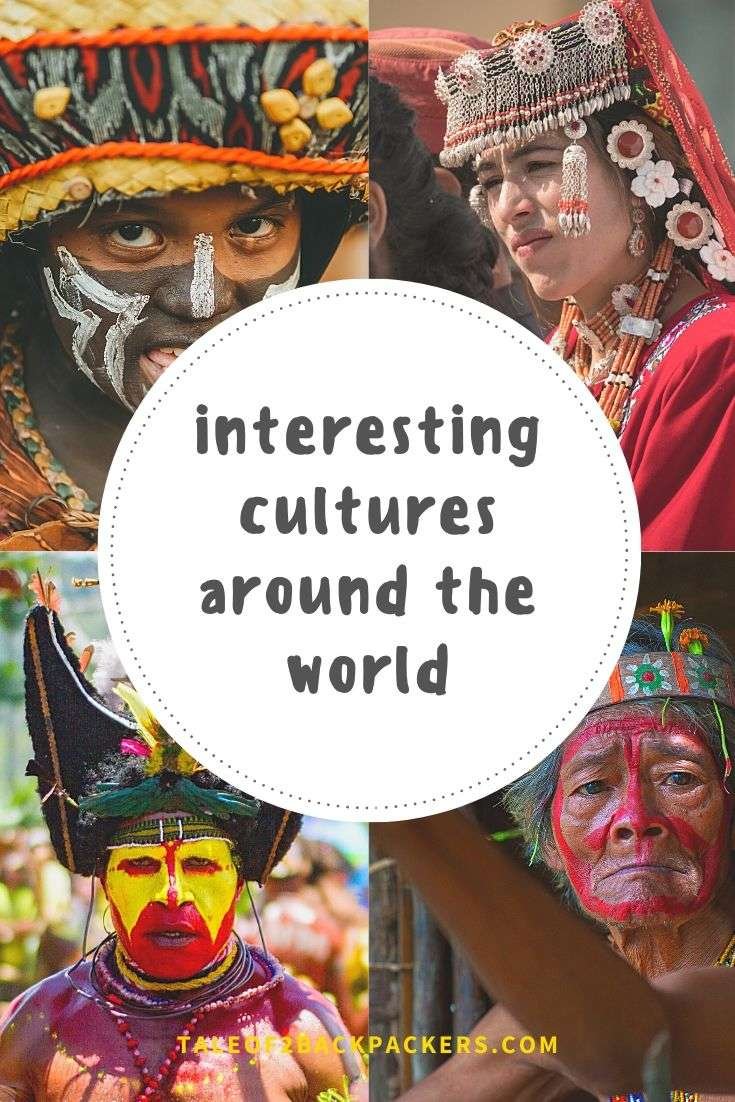
Contents
Unique and Interesting Cultures around the World
- Head Hunters of Nagaland, India
- Nyishi Tribe from Arunachal Pradesh, India
- Kalash People, Pakistan
- The Khasi community of Meghalaya, India
- Tibetans, Tibet
- Rungus, Sabah
- Akhu Tribe, Kengtung Myanmar
- Thai community who offer Red Fanta to God, Thailand
- Black Hmong, Northern Vietnam
- Akha, Laos
- The Bajo people of South East Asia
- Toraja, Indonesia
- Kazakhs, Kazaksthan
- Khinaluq people in Xinaliq, Azerbeaijan, Europe
- Scottish Culture
- Sami, Lapland
- Nubians, Egypt
- Berber, Morocco
- Masaai, Africa
- Himba, Namibia
- Omo, Ethiopia
- Zapotec, Mexico
- Wayuu, Colombia
- Quechua People, Perú
- Taos Pueblo, Mexico
Interesting Culture around the world – Asia
1. The Head Hunters of Nagaland, India
Contributed by Amrita from Experience Northeast
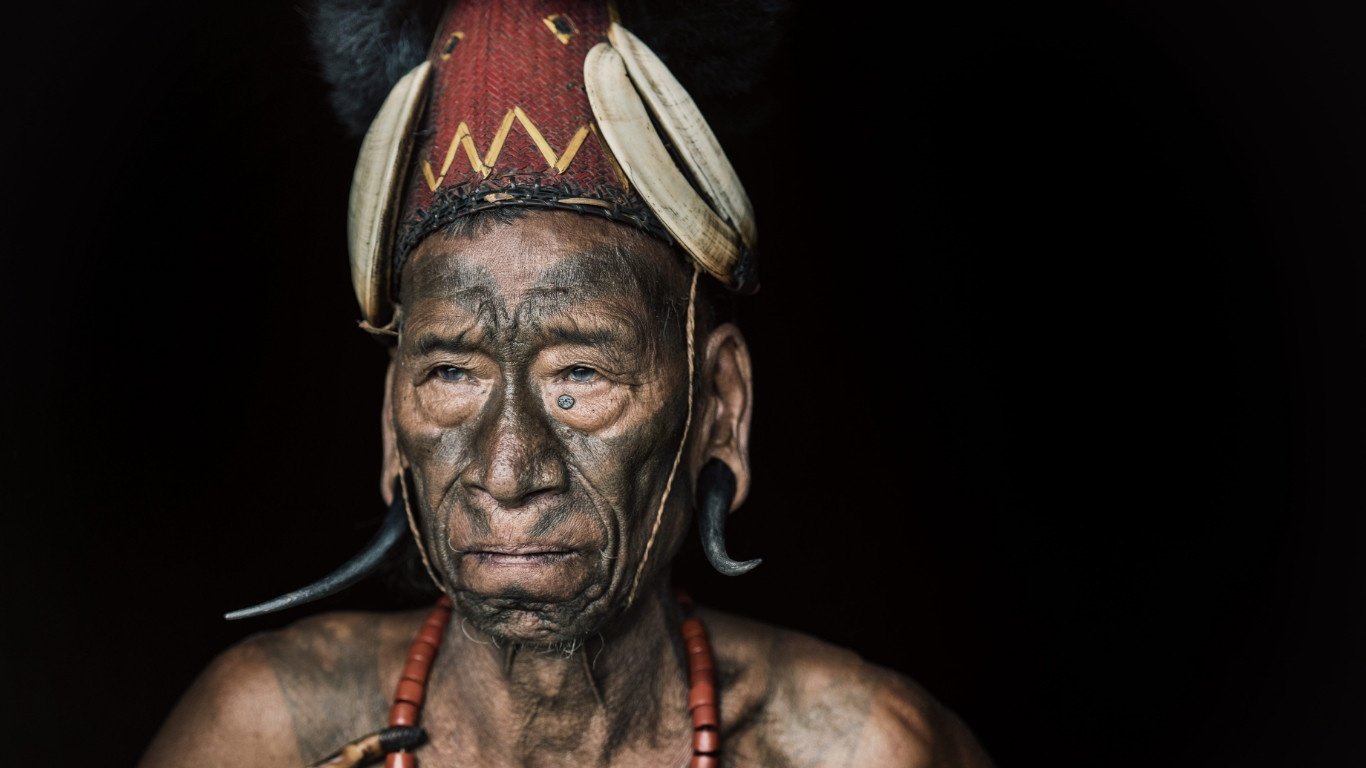
Northeast India is the home to many fascinating tribes and interesting cultures around the world, but the Konyak tribe or the fierce headhunters of Nagaland seems to be the most intriguing to us. One of the largest tribes in the remotely located Nagaland, Konyaks are known for their valour who took pride in severing the heads of their opponent warriors as trophies to be hung at their Morungs (a traditional community house). The Konyaks are seen in the remote village of Longwa in Mon district of Nagaland.
Even till 1969, headhunting was practised in Nagaland. The Konyaks believed that a young man’s passage to manhood could only be completed after he would bring back a head to the village. So they used to fight their enemies to kill, rip off their heads and bring the head back to decorate the Morungs. With each kill, they got a tattoo on their face and chest, which is perhaps one of the most intriguing aspects of the tribe. These tattoos define their honour and pride and the Konyaks believe that if they did not get a tattoo, they would not be able to get a good afterlife.
However, with the advent of modernity, things have changed. Now, the Konyaks are no longer headhunters, but they still retain their brave and fierce disposition. There are now only a few headhunters left in the Longwa village. The best time to see the KonyakNagas is to visit during the Aoling Festival that usually takes place in April every year.
2. Nyishi Tribe from Arunachal Pradesh, India
Contributed by Anjali from Travel Melodies
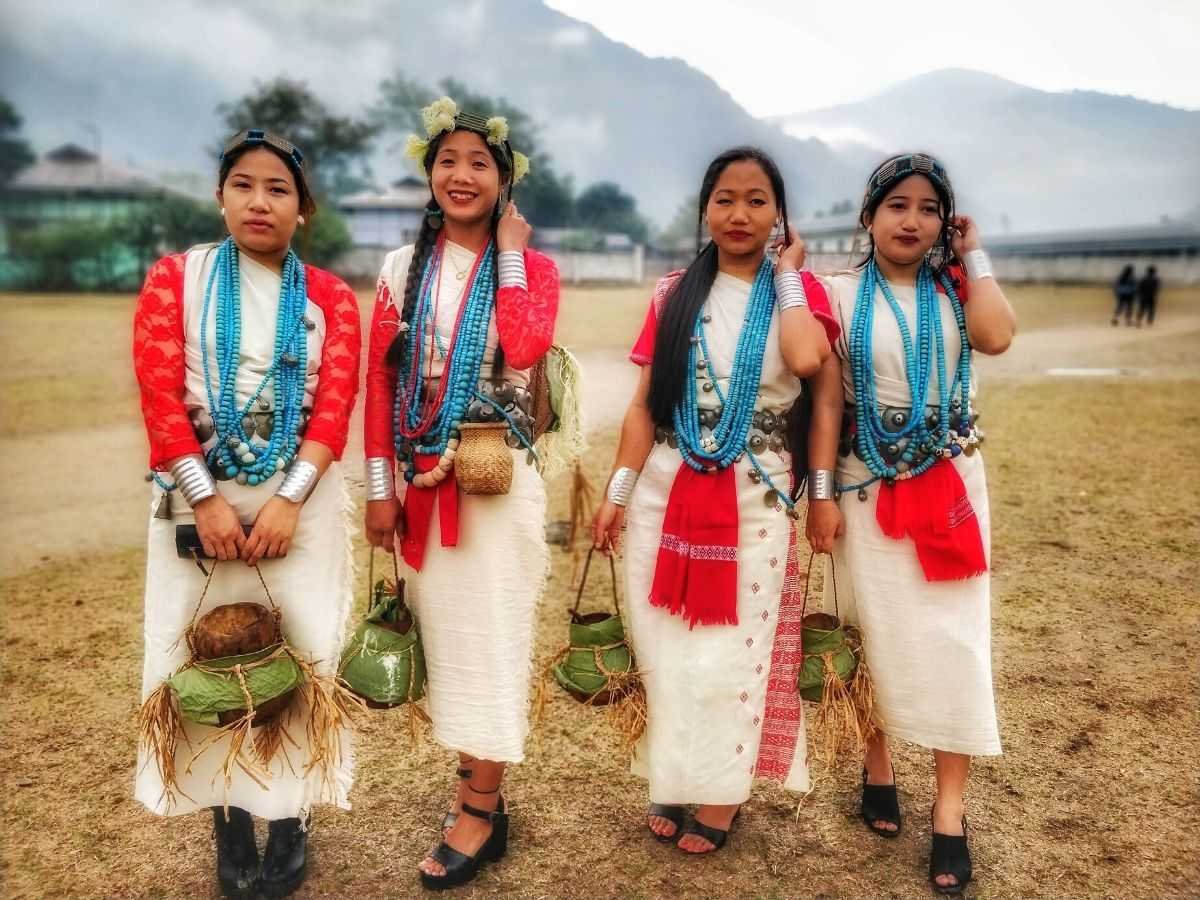
Arunachal Pradesh in north-eastern India has 26 indigenous tribal groups, and the Nyishi tribe is one of the largest of them. The cultural practices and beliefs of Nysihis resemble those of Mongoloid tribal groups from Myanmar. Nyishis call themselves the descendants of Abo-Tani, a mythical forefather.
They speak Tibeto-Burman and yet to develop a script. As they don’t have anything in writing, it’s interesting to know that they pass their culture, rituals, and history from one generation to another through an intriguing oral tradition of folklore. Nyishis’ belief in their culture and rituals is unwavering. They believe that rituals, when not performed religiously, can invite trouble.
Mithun (traditional cattle) plays an important role in all the aspects of life – be it social, cultural, economic, or religious. Groom pays the bride price in the form of Mithun during the marriage, and they sacrifice Mithun (sacred to them) to appease their deity in almost all the ceremonial rituals.
I found their Traditional Grain Analysis (Amyemch Hikanam) Ritual quite intriguing where the priest holds a measuring cup made of bamboo and asks a woman to fill it with grain and predicts her future based on the way she filled the cup. Isn’t it interesting?
Unlike our urban society, Nyishis are quite progressive. They treat their women equally and involve them in the decision-making process.
I loved their people, culture, traditions, dance (Rikham Pada), their attire, their homes (Namlo) and their local brew apong served in a beautiful patha ( a goblet made of bamboo shoots). In this fast-paced and competitive world where people are trying to pull each other down, they live in absolute peace and harmony. Simple, honest, ever-smiling, and realistic, Nyishis respect their culture and nature. They accept things the way they are and don’t try to change anything for their selfish motives. Plus, they are amazing hosts
3. Kalash People
Contributed by Alex Reynolds from Lost With Purpose

The Kalash, one of the most interesting cultures around the world, is a unique people hailing from three small valleys in the mountains of western Pakistan: Bumburet, Rumboor, and Birir make up the Kalash Valleys. Located in northern Khyber Pakhtunkhwa province, the valleys lead to mountains bordering Afghanistan.
The Kalash people are unique in multiple ways. Some researchers believe they are descendants of the armies of Alexander the Great; some of his men stayed behind on the Indian subcontinent after his campaign through the region. Although this is a common claim in Pakistan and India, the Kalash are the only people whose genes show an injection of European DNA around the time of Alexander’s campaign.
Verity of the claim aside, there’s no denying the Kalash people look nothing like their neighbours. Many men and women have fair skin and light eyes, a colouring uncommon in South Asia.
The Kalash people also have their own religion and culture. Although Pakistan is a Muslim majority country, the Kalash are animists. Kalash culture is believed to be linked to ancient Hinduism. The Kalash people make—and consume—their own alcohol. Women wear brightly coloured dresses and headpieces with embroidery unique to the Kalash people.
The epitome of Kalash culture can be witnessed during one of three big Kalash festivals. At each festival people dress up, drink, and dance while praying for a successful harvest, protection for their animals, etc.
Though I recommend you visit the Kalash Valleys if you ever make your way to Pakistan, please be mindful of their traditions and culture, and treat them with the respect they deserve.
4. Khasi community of Meghalaya, India
Contributed by Zinara from NatnZin
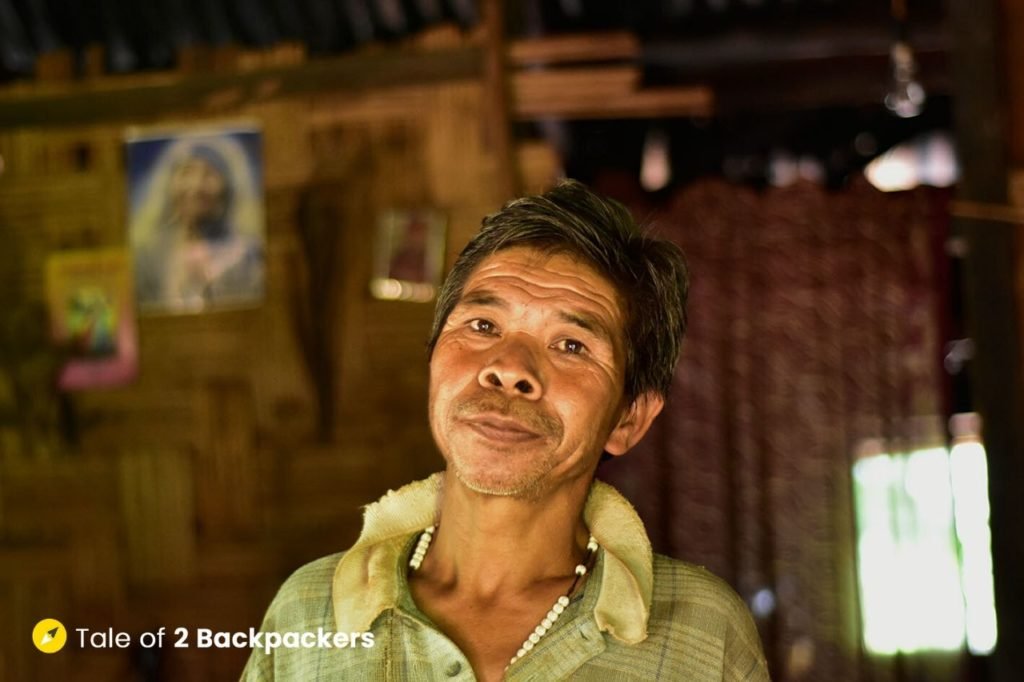
The Khasi community is the main indigenous group calling home to the Indian state of Meghalaya. They are a matrilineal community. Here, the property belongs to the youngest daughter of the family. Children receive the last name of the mother. It also involves matrilocal residence, which means that after marriage, the husband comes to reside with the wife’s family. Owing to all these reasons, Khasis live a very different life from their mainland Indian counterparts.
The first time I went to Meghalaya, it was the month of August in 2018. My local guide Khraw took me to bustling markets. Chattering women sat next to each other. Others carried baskets full of feathery chicken on their heads. Women dressed up in local Khasi dresses chopped meat. It was an egalitarian society.
I noticed a close-knit society everywhere I went. Khraw hails from Mawsynram—it’s the rainiest place on earth. “If someone doesn’t have a house in our village, we get together, give them a plot of land and build them a house,” Khraw told me. “They can cultivate the land to earn a livelihood.” The Khasi community is also very close to nature and they live in perfect communion with nature.
5. Tibetans, Tibet
Contributed by Wendy Werneth from The Nomadic Vegan
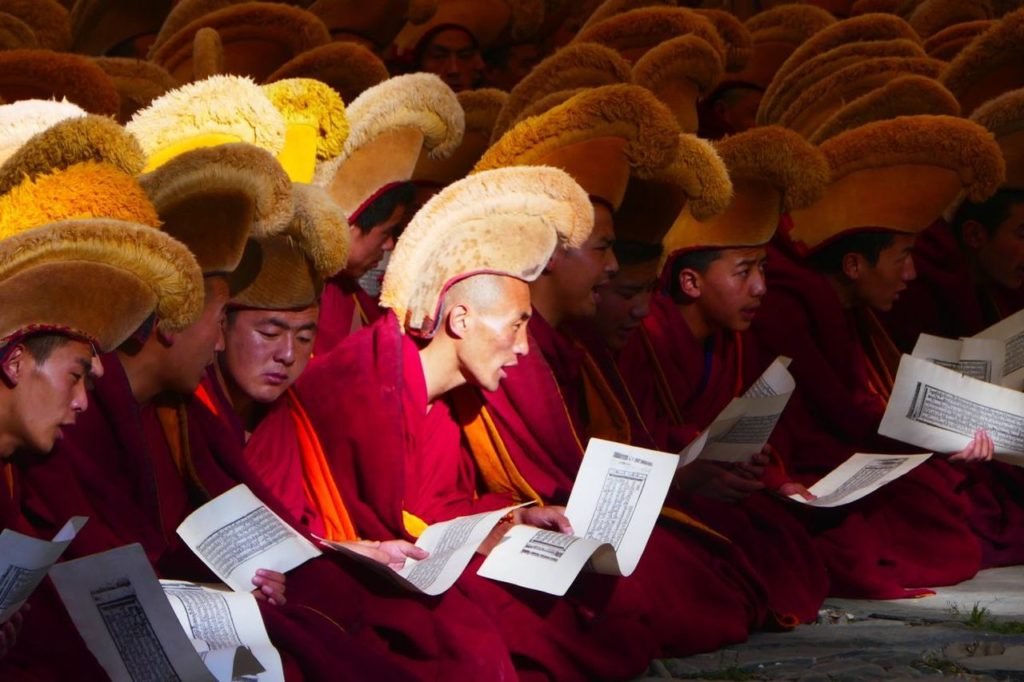
I’ve been intrigued by Tibetan culture for many years, ever since reading My Journey to Lhasa by Alexandra David-Néel. In this account of how she entered Lhasa disguised as a Tibetan beggar to learn about Buddhism from Tibetan lamas, David-Néel shows deep respect and fascination with Tibetan Buddhism that I found to be contagious.
I’ve encountered Buddhism in plenty of countries around Asia and have always related to and connected with its teachings of compassion and non-violence towards all sentient beings. But the Tibetan form of Buddhism always seemed so mysterious, and I was enchanted by the eerie tones of the singing bowls, the deep guttural vibrations of the chants, and the vibrant colours of the sand mandalas.
While you’re probably already aware that Tibetans are from Tibet, it’s important to note that the Tibetan Autonomous Region, as it’s been defined by the government of China, is not the only place where Tibetans live. In the past, Tibet included a much larger area, now part of the Chinese provinces of Gansu, Sichuan and Qinghai. In some areas of these provinces, the majority of the population is still made up of ethnic Tibetans.
These areas are arguably even more rewarding to visit because, unlike the Tibetan Autonomous Region, foreigners are allowed to visit these places on their own. A visit to the Labrang Monastery in Gansu province, for example, can be a great way to experience Tibetan culture independently without having to join a tour group authorized by China. Just be aware that some parts of these provinces remain completely closed to foreigners, and these regulations can change at the drop of a hat, so be sure to check official websites for the latest updates.
6. Rungus, Sabah
Contributed by Leyla Giray Alyanak of Offbeat France

Inuliah Itam is a member of the Rungus tribe, one of several dozen tribes found in Sabah. Here, she prepares a feast for guests and extended family members
With young people headed to the cities for jobs, the future looked grim for ethnic groups like the Rungus, who live near the tip of Borneo in Sabah, on the Malaysian side of the island. But tourism may save their culture by encouraging them to revive traditional crafts such as dancing, gong-making, playing the nose flute and building traditional longhouses. I was fortunate to spend a few days living with a Rungus family, taking part in their daily lives.
Much of that life centres around food, which is grown on family-owned land and cooked fresh each day: rice, plenty of green vegetables I didn’t know, fish of course with the sea nearby, and chicken. None of it was particularly spicy but it was delicious, and it was filling.
In the nearby village of Kampung Sumangkap, gong-makers hammer and shape zinc sheets into curved, vibrating instruments. This traditional skill is important – the gong is the most highly prized musical instrument in Rungus culture and is used for all major events. It also faced a dim future until the Rungus realized visitors would enjoy the gong-making and buy gongs to take home, providing much-needed income to local communities.
With the upswing of tourism in Sabah villagers are now able to supplement their income with traditional crafts, gong-making of course, but also bead-stringing, dancing, singing, nose flute-playing, and maintaining longhouses. While young people still migrate to cities, they can now choose to stay closer to home because jobs are available.
7. Akhu Tribe, Kengtung Myanmar
Contributed by Maya and Sari from Chasing Lenscapes

Kengtung (or Kyaing Tong) is located in the Shan State in Myanmar, and it is one of the best places to visit if you want to learn more about Myanmar’s cultural diversity (there are more than a hundred of distinct ethnic groups in Myanmar). The Kengtung district is part of the golden triangle of Southeast Asia. Therefore, there are various influences from the nearby countries, and some of the local tribes can be found in the neighbouring states as well.
During our visit to Kengtung, we visited some of the local tribes. One of our most memorable visits was the one to the Akhu village. The Akhu women are known for their long bamboo pipes, which they like to smoke and will demonstrate gladly for their guests. They wear black headwear (similar to a turban), and most of their attire is black too, except for the colourful bead necklaces and their beautiful silver earrings. Their homes are very simple, wood huts without any decorations, no running water, and no electricity. The local guides try to do what they can in terms of helping the local communities.
In terms of religion, the village used to be an animist village, but like many of the tribes in the area, the villagers were converted to Christianity by missionaries.
We were invited to a local house, and with the help of our guide, could carry on a conversation with our hostess. Her friendly demeanour made us feel comfortable, and we could tell she loved to smoke her long pipe for us and tell us about her daily life. It seems that the women of the village live well into their 80s or even 90s, which is extraordinary considering the low level of medical care. The men, however, rarely pass their 60s. It is hard to explain this difference since both men and women work very hard. Anyone who loves to experience interesting cultures around the world and likes to explore hidden gems, should try and make an effort to visit Kengtung in Myanmar.
8. Thai community who offer Red Fanta to God!
Contributed by By Abhishek & Neha from Revolving Compass.

On our 2 weeks Thailand trip, one thing that caught our attention everywhere we went was a red Fanta bottle sitting in front of God idols, and that also with a straw! This is one interesting culture around the world that we have witnessed.
The first time we noticed it was near a Ganesha statue in front of a mall in Bangkok. Then we simply thought someone ignorant left it there. The next day, we saw two bottles on the same spot, along with a bowl of eggs! It appeared as some kind of ritual now. We have seen different kinds of offerings, but never a soft drink given to God! Was it that the hot and humid climates of Thailand made even the Gods crave for soft drinks? Intrigued, I couldn’t hold myself anymore and inquired from a local Thai in Doi Suthep. Next, an interesting story unfolded.
The traditional Thai culture is highly rooted in the Indian subcontinent. For thousands of years, sacrifices to daemonic Gods including human, animal and blood sacrifices have been its integral part to please the spirits and keep them from interfering with the lives of common people. As civilizations matured, at some point, such sacrifices were banned. And each region saw the evolution of an alternative.
In Thailand, it emerged in the form of red Fanta, whose colour is so close to blood! And the modern Thai community started offering red Fanta to Gods! In fact, Thailand is one of the highest consumers of Red Fanta today. And most of it actually goes to the Gods. Interestingly, if a Thai drinks red Fanta, he is actually fawned upon and made fun of in his community for showing “daemonic symptoms”!!
9. Black Hmong, Northern Vietnam
Contributed by Marya from The Beau Traveler
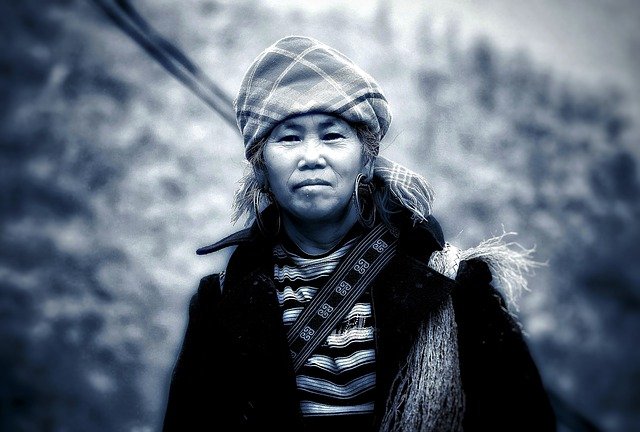
The Black Hmong is the minority ethnic group who reside in Northern Vietnam. The ethnic group has settled in some villages around Sapa town, like Supan, Lao Chai, and Cat Cat Village. I got the opportunity to meet them in Sa Pa a few years ago when I travelled solo to Vietnam for the first time.
My first encounter with the Black Hmong people was when I did the trekking tour around Lao Chai, and what amazed me was that all the Black Hmong people who got involved in the tour were mostly women. If anything, I barely found any Black Hmong men in sight except a few times when we passed the rice fields.
As it turned out, the Black Hmong is ethnic with strong feminist values in their customs and culture. They recognize gender equality, and most of Black Hmong’s families have both men and women as the breadwinner in the family. While Black Hmong women usually rely on their embroidery skills to make their ends meet, the men usually master skills like handling livestock or cultivating crops.
Apart from that, most Black Hmong women also work as a tour guide for the tour around their villages. However, if you join a group tour, even though the tour has the designated guide for you and other people, chances are you will be followed by some of these Black Hmong women who would interact with you throughout the tour, and help you during trekking. Mind you, the trekking track around Sapa town is so hilly that it might be difficult for some of us. I know because it was for me.
10. Akha, Laos
Contributed by Marie from A Life Without Borders
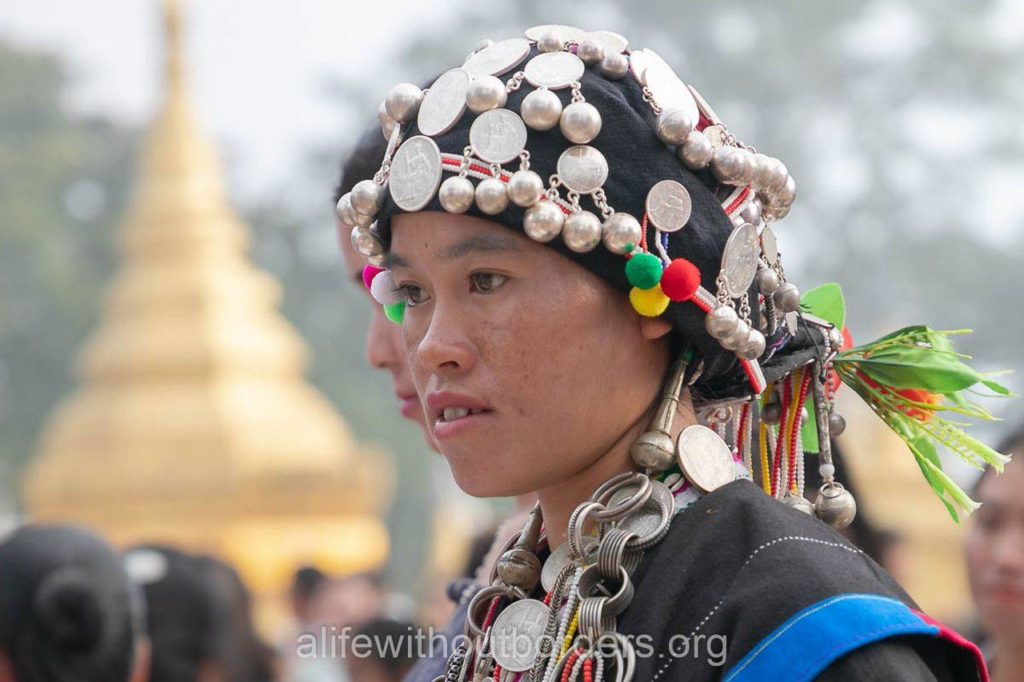
The Akha are a minority ethnic group living in the remote, high mountain regions of Laos, China, Thailand and Myanmar. Easily recognisable by their decorated headdress full of silver baubles and coins, the Akha in Laos are only found in the far northern Luang Namtha province. I encountered Akha women at a village in Muang Sing, Laos where I was fortunate enough to spend the day learning about their textiles and tribal clothing.
Despite rapid economic and social changes, the Akha are one of the interesting cultures around the world and they continue to practice many aspects of their customs and traditions. The Akha way of life is infused with strong family ties and strict rules. Generally living in stilted bamboo houses high in the hillsides, the huts are divided by gender, with one half occupied by women and the other half used by men.
Akha men are expert farmers and hunters, whilst the women are masters at weaving and sewing. In fact, Akha women are one of the few ethnic groups in Laos who continue to eschew modern clothing in favour of their traditional costume. Consisting of a distinctive headdress, a short black skirt and vest and brightly coloured leggings, most elements of the outfit are decorated with silver balls, buttons and coins, all embellished with brightly coloured threads. Incredibly, Akha women never remove their headdress – they actually sleep with it on, covered with a simple cloth to protect it.
Entrance to an Akha village is also easily recognised by a large wooden frame, known as a “spirit gate”, hung with talismans and carvings. The spirit gate marks the divide between the spirit realm outside the gate and the world of the Akha people, inside. The gate effectively serves to stop evil spirits from entering and keep the favourable spirits inside.
11. Bajo people of Southeast Asia
Contributed by Campbell and Alya from Stingy Nomads

As a scuba instructor and keen free diver that loves the ocean, I have always been fascinated by the Sama-Bajau or Bajo people, a nomadic sea living tribe known in popular culture as the sea gypsies or sea nomads. The Sama-Bajau have been a nomadic, seafaring people living in South East Asia in the ocean surrounding the Philippines, Indonesia and Malaysia for hundreds of years. I was very privileged to spend a couple of days in a Bajo settlement in Indonesia. The country Indonesia is made up of more than 17,000 islands, some of them tiny. The Bajo settlement I stayed at was located at the small island, Pulau Papan, one of the Togean Islands with the closest large island being Sulawesi.
For years this tribe has been living off the sea by trading and subsistence fishing. The Bajo are known to be boat-dwelling and traditionally many of them spent their entire life at sea. Even though there are still some of the tribes living on small boats at sea, most of the modern
Sama-Bajaulive close to the shore by erecting houses on stilts, and they travel by using lepa, handmade boats. We were hosted by a local family and paid them for food and accommodation; the people were very hospitable and friendly. The freediving ability of the Bajo is legendary with some sources stating they can hold their breath for up to 5 minutes while hunting fish spearfishing. It was amazing to go spearfishing with them, using traditional homemade equipment.
12. Toraja, Indonesia
Contributed by De Wet & Jin from Museum of Wander

On the island of Sulawesi in Indonesia is a valley surrounded by mist-clad mountains. The name of this valley is Tana Toraja or Toraja land, and this is the home of the Toraja people. These mountains have protected the Torajas and their culture for centuries, and today this valley is one of the most unique places in the archipelago.
The Torajas, one very interesting cultures around the world, are tall, proud people and their most valuable possessions are their water buffaloes. You’ll see men grooming their buffaloes and decorating their horns and ears with flowers and colourful leaves as you explore the valley. The shape of the intricately decorated houses in which the Toraja people live are also inspired by the shape of buffalo horns.
Toraja land is most famous for its elaborate funeral ceremonies. When a person passes on, the Torajas merely consider them to be sick, and the body will remain living with the family (inside a coffin) in the house. In the meantime, the family will start saving up and preparing for a proper send-off, which might take place a year or longer after the family member had passed on.
Funerals in the valley are a grim yet fascinating event, and should definitely not be missed if you visit TanaToraja during the funeral season. The Toraja people believe that souls will only leave the earth once a buffalo is sacrificed, and on a funeral day, at least six of these buffaloes will meet their end.
Afterwards, the meat gets divided between the community and a feast is prepared for the entire funeral guest. Funeral season in Tana Toraja runs between May and October, and you’ll definitely get invited if you are in the town of Rantepao during that time.
13. The Kazakhs, Kazaksthan

The Kazakhs are semi-nomadic people originating from northern parts of central Asia. They are mainly pastoral communities moving several times a year with their herds along the mountains of Kazaksthan and in some parts of Mongolia as well. The origin of the Kazaks is believed to date back to the 15th century.
It is said that fine horses and fierce eagles are the wings of Kazakh people.
The tradition of hunting with eagles is an important part of the Kazakh culture. The Kazakhs used to hunt foxes and hares from horsebacks and had their eagles trained to detect intruders from great distance. They sometimes rode great distances for hunting in order to provide for their families. Today, hunting with eagles is officially recognized as a national sport,however, the falconers no longer practice it from horseback.
According to tradition, when a boy turns 13, his father starts training him to hunt with eagles. The tribe captures young female eagles that are not yet old enough to fly and raise them. After seven years they are returned to the wild to breed.The annual Golden Eagle Festival is an important festival in Kazakhstan where wolf-skin clad Kazakhs take to the mountains on horseback with golden eagles soaring high in the sky as they celebrate their
Interesting cultures around the world – Europe
14. Khinaluq, people of Xinaliq in Azerbaijan
Contributed by Ellis from Backpack Adventures

The Caucasus is one of the most multicultural areas in this world with a high diversity in languages and cultures. Already before I went to Azerbaijan I read an article about Xinaliq and its people that believe they are the direct descendants from Noah.
Xinaliq is one of the highest villages in Europe. It lies in the northeastern corner of the country close to the border with Dagestan in Russia and is so remote that the unique Khinaluq people have kept their own language and cultural traditions for centuries. Most noteworthy is their language that is not related to any other language in the area.
Obviously, I wanted to visit this place and this turned out to be easier than I thought. Tourism has become a welcome additional source of income for the people of Xinaliq. A number of welcoming homestays have opened their doors to foreigners to show them their way of life.
Xinaliq is a proud and resourceful mountain community. Despite language barriers, they are happy to share aspects of their culture and how they survive in the harsh climate of the mountains. The surroundings are absolutely spectacular, but life can be difficult up here.
It was a unique experience to stay with a family for one night and witness firsthand how they make bread, milk their goats and bring back their grazing sheep from the mountains. The lady of the house was shy at first, but eventually opened up to me.
Although the Khinaluq people are now Muslim they also kept some traditions from their animist past. Locals are happy to guide you around and show you some of the animist shrines that are still in the area. The hiking opportunities are great and the views on the mountains are the best in the whole Caucasus.
15. Scottish Culture
Contributed by Kat from Wandering Bird

Ask anyone to describe Scotland, and they’ll probably mention things like ‘tartan’, ‘music’, ‘kilts’ and ‘haggis’.
And they’d be right. Along with the incredible scenery (some of the world’s most scenic drives are in Scotland), it’s the people which really make the place. Their history, traditions and hospitality are woven into the fabric of the entire country- it’s impossible to separate the two.
Some of the most interesting traditions include:
- Each clan has its own tartan design and colours and they are VERY proud of it. Wearing the ‘wrong’ tartan is a huge insult and yes, they do take this stuff seriously. Being given your first kilt (boys) or dress/ sash (girls) is part of growing up and a memory every Scot treasures. The kilts/ traditional dress are worn at every formal social occasion, as well as many parties and events throughout the year (the Scottish LOVE to party!) Every Scotsman I know is well used to people asking what they’re wearing underneath. Give him enough to drink and he might even show you!
- Talking of which- don’t try to outdrink a Scot (male or female!) It will end badly… for you!
- This is one of my FAVOURITE Scottish traditions. Hogmanay means ‘last day of the year’ and is the New Year’s Eve celebrations. These traditions are not like today, when we hire a car Enterprise and eat the whole family in a country house for a festive dinner. Traditionally, the house is cleaned from top to bottom, ready to start the New Year ‘fresh’. As the clock strikes midnight, revellers everywhere link arms and sing Auld Lang Syne, and then start the process of ‘first footing’. First footing means being the first person to cross the threshold of another household. You bring a small gift; whiskey, fruit bread, coal (for warmth), salt, or shortbread is traditional. The first footer is welcomed with a ‘wee dram’ of whiskey and is supposed to set the ‘tone’ for the year ahead.
16. Sami, Lapland

Sami culture is one of the oldest cultures coming from the region of Sápmi that includes northern parts of Sweden, Finland, Norway and the Kola Peninsula in Russia. The Samis are descendants of nomadic people who had inhabited northern Scandinavia for thousands of years.
Reindeers are quite important for the Sami way of life. The economy of the Sami people mainly depended on reindeer herding. They were once nomadic in nature and migrated from place to place with their reindeer herds. However, of late, only the herders move with their reindeers while their families reside back in modern and permanent dwellings. Traditionally, the livelihood of the Sami people consists of fishing, livestock farming and hunting along the coast and on the fjords.
The Samis have their traditional outfits known as the Gakti. They wear them at parties, festivals, weddings, baptisms, funerals and other special occasions.
Interestingly, there are nine different Sami languages, closely related. However, today mainly three are used. The Samis have their own parliaments to represent them in Norway, Sweden and Finland. They have their own newspapers and radio stations that report on issues concerning their own.
Interesting cultures around the world – Africa
17. Nubians, Egypt
Contributed by Nadine from Curls en Route

One of the most interesting cultures around the world that I find truly fascinating is the Nubian culture. Nubians are one of the most ancient ethnicities still living to this day, who live in Nubia, a region that stretches from Aswan in Upper Egypt to Khartoum in Sudan. I haven’t been to Sudan so I’ll be talking about the Egyptian part of Nubia, a place that I’ve always loved going back to.
Nubian villages in Egypt are best known for their folkloric music, their vibrant, colourful houses by the Nile’s banks, and for the hospitable, friendly locals. Staying at a Nubian guesthouse, where a local hosts you in his very own home is a beautiful experience that you shall surely enjoy. You’ll get to learn more about the ancient region’s rich history, their interesting culture, and taste one of the world’s finest cuisines during your stay. Just expect some reptile action as Nubians tend to raise crocodiles as pets!
Another fun fact about Nubians is that they have their very own language. It’s a spoken and an unwritten language that they still practice to this very day as a way of preserving their culture that’s old enough to have witnessed the Ancient Egyptian civilization.
I have personally had plenty of memorable experiences in Nubia. The closest one to my heart was when I got really sick during my very first visit to Gharb Sohail Island. The kind Nubians took good care of me and helped treat me with natural herbs as they don’t use chemical medication. I’d have to say, it’s way more effective!
18. Berber, Morocco
Contributed by Daniela from Grumpy Camel

My encounter with Morocco’s Berber communities has been quite fascinating and the Berbers are one of the most interesting cultures around the world. In 2014, my husband and I went on a hiking trip to Morocco, where we spent a couple of days in the High Atlas Mountains. There, we got to stay with a Berber family and learn more about rural life in Morocco.
The Berbers, or Imazighen as they are known in their native language, are an ethnic group native to many North African countries, including Morocco, which they have inhabited for at least 5,000 years. Many Berber communities in Morocco live in rural villages across the Atlas Mountains. Traditionally, Berbers were farmers and traders. Although many people of Berber heritage nowadays live and work in Moroccan cities, most Berber families in mountain communities still make a living from agriculture. Typically, Berber women work in the fields and weave blankets from dyed wool, while the men travel to markets in nearby towns to sell or trade their produce and livestock.
During our stay at a Berber village in Morocco, we were treated to delicious traditional meals cooked in tagines – conical clay pots that are used as cooking pots as well as serving dishes. The ingredients, which often consist of couscous, vegetables and meat or chicken, are placed in the pot and cooked on an open fire. Our dinner was followed by traditional Berber entertainment – singing, drumming and dancing in a circle. Songs are passed on orally from generation to generation and Amazigh families often come together to sing and dance to hypnotic drumming produced on bendirs (circular hand drums). It was a truly magical experience, made more special by the hospitality and kindness of the Berber families we met along the way.
19. Masaai Tribe, Africa
Contributed by Joanna from The World in my Pocket

The Maasai Tribe is an ethnic group of people who live a semi-nomadic life, in Kenya and the north of Tanzania. They are known for their colourful attire and their traditional dance, in which the warriors of the tribe jump as high as they can.
The Maasai live a simple life, in villages with houses made out of cow manure. Men mostly take care of the cattle, whilst women stay at home to cook and take care of the children. Maasai take a lot of pride in their cattle, which is a symbol of their status. The Maasai, traditionally, only eat raw meat, drink raw blood and raw milk. They have rituals which involve drinking the blood of the cows on special occasions such as circumcisions, birth or marriage.
In Tanzania you can visit a Maasai village, to learn about their culture and traditions. Some villages are more touristy than others and charge more. I organised a tour by myself and I was lucky for the guide to be a Maasai from that village, who was now living in Moshi town. I felt that the village I visited wasn’t on the tourist path and that they didn’t get many visits from foreigners. They were not pushy at all, they seemed genuinely happy to show me their culture.
I found the Maasai fascinating because of the way they live and their culture. The newer generations are receiving an education by going to school and are getting jobs in the nearby towns. However, they still maintain their traditions; they still dress the same and refuse to eat grains.
20. Himba tribe in Namibia
Contributed By Sabine and Sean from The Travelling Chilli

The Himba are one of the 13 ethnic tribes of Namibia and probably the most well known internationally. They are a semi-nomadic tribe who originate from the north-western part of Namibia and have since spread out to other parts of the country where visitor centres have been set up in order for tourists to gain a better understanding of their culture and history.
What is interesting to note about these real-life visitor centres is they have been set up in such a way as to try and preserve the original Himba culture without too much interference from the outside world. One such way that they avoid the influence of the modern world is that these centres are located quite far from any major city, town or village. However, I have seen Himba’s using cell phones from time to time and they also know what the internet and a television is.
While the Himba men don’t dress up in anything too special, the women on the other hand will adorn themselves with nothing other than a single leather loincloth. They will go on to cover themselves entirely in a red ochre powder-based ointment made out of incense and butterfat which gives their skin a very soft silky feel. They will also braid their hair extensions with the same mixture. Each Himba tribe also wears specific jewellery much like the Scottish clans will each have their own kilt designs.
So, when you are next looking for things to do in Namibia, I highly recommend making time for a visit to a Himba village.
21. Omo People
Contributed by Oksana & Max from Drink Tea & Travel

The Omo Valley tribes are a resilient group of people living in Southern Ethiopia. They are largely unaffected by the outside world and are recognized as practitioners of some of the world’s oldest cultures and traditions and are one of the most interesting cultures around the world.
The 16 plus indigenous tribes living in the valley have followed in their ancestor’s footsteps for hundreds of years. They don’t have electricity or other modern amenities. They have a different set of values and cultural norms which sometimes include wearing colourful garb or painting their bodies.
Each tribe has slightly different traditions, different languages, and proficiencies. But overall it was fascinating to learn about their culture and the Omo Valley tribes’ deep connection to nature. The tribes rely heavily on the changing seasons, annual floods and other environmental phenomenons for their livelihood. The landscape of the region can be unforgiving, so we walked away with a deep respect for the Omo Valley tribes.
Omo Valley may not be the most accessible place to get to on a trip to Ethiopia but that is not reason enough to scratch it from your bucket list. Relatively few tourists visit the valley and Ethiopia tourism is pretty undeveloped in the area so walking around the villages you will get a sense of the refreshing authenticity of the region and its people.
Interesting cultures around the world – South America
22. Zapotec people, Mexico
Contributed by Rose from Where Goes Rose?

While most people think of Mexico as a predominantly Spanish speaking country, there are in fact 68 national languages. This is because of the number of indigenous groups around the country, many of whom have spoken their native dialects, which bear no resemblance to Spanish for centuries, for centuries. One such group are the Zapotec people who are mainly found in Oaxaca state, as well as the neighbouring states.
By visiting Zapotec villages such as the 8 protected Pueblos Mancomunados villages in Southern Mexico, you can not only support a protected region of eco-tourism but also meet the indigenous people who call it home. One such village is Benito Juarez which can be visited from Oaxaca City as a day trip or overnight trip.
Before ending your trip to Mexico, you might want to go on an exotic Cancun tour known for its beaches, numerous resorts, and nightlife. It’s composed of 2 distinct areas: the more traditional downtown area, El Centro, and Zona Hotelera, a long, beachfront strip of high-rise hotels, nightclubs, shops, and restaurants. Visit this website to book a trip or explore further.
I visited the lofty village surrounded by forests and mountains with a local guide who shared information about the Zapotec people we met. Even if you visit Mexico as a Spanish speaker, this is advised as many Zapotec people don’t speak Spanish so you’ll need a guide to communicate in their dialect. The locals wore hand embroidered colourful garments and eat vegetarian-based meals which can be tried in Benito Juarez village. The Zapotec people here live in modest homes built from the surrounding woodland. For incredible scenery and a memorable cultural exchange, add a Zapotec visit to your Mexico bucket list.
23. Wayuu Tribe, Colombia
Contributed by Daniel from Layer Culture

When looking for unique and interesting cultures around the world you sure don’t want to miss out on a chance to see, or even visit, the Wayuu people. Located in the most northern point of the South American continent, you can find the Wayuu tribe who make up one of the many indigenous American ethnic groups in Colombia.
After spending many weeks backpacking Colombia I have been fascinated by the work of the ingenious Wayuu tribe as their handmade bags are sold all over the country. One day I decided to get one step closer and take a trip to La Guajira region of Colombia; which is where the tribe and its community reside. My first encounter with the tribe was in a place called Riohacha.
After seeing the tribe sat with their fascinating bags presented in a very orderly fashion along the sidewalk, I instantly bought one. Not just because the price was competitive but my goal all along with visiting the region was to buy a Wayuu bag from the tribe itself and not from a wholesaler in the bigger city. I found the tribe women to be very astute when it comes to business and even though you can negotiate on the price, they did drive a very hard bargain. In Colombia, the Wayuu are known for their colourful woven bags and after buying one I will treasure mine for many years to come.
24. Quechua People of Perú
Contributed by Heather Trimm from Trimm Travels

Learning about the indigenous people of any destination I visit is quite interesting to me. However, none have fascinated me and captured my attention quite like the Quechua people of Perú.
While Perú is the country of origin, other Quechua speaking indigenous people also live in Argentina, Chile, Bolivia, Colombia, and Ecuador. Because of this, you may hear them referred to as the indigenous people of South America.
Adopted as Perú’s second official language in 1969 (Spanish is the first), around 4 million people speak the Quechua language within the country. There are different dialects with the most common being Southern Quechua.
There were several reasons I became fascinated with the people while travelling through Perú. One was that the Incas spoke the Quechua language. The Incas are the amazing empire behind the creation of the astonishing Machu Picchu. Although there are no Incas around today, the language is still very strong throughout different regions of Perú.

The biggest reason I became fascinated with the Quechuas is learning how strong they are physically, mentally, and emotionally. They are extremely hard workers as they traditionally come from farming and agricultural backgrounds. They also have endured a lot of persecution as recently as the Peruvian Civil War which took place in the 1980s.
Quechuas are a diverse group. Some are very quiet and introverted, continuing to live on their family-owned land and dressing in their colourful traditional attire. Others are a little less traditional and have adapted to more modern culture and can be encountered singing and playing the guitar in bars in Peruvian cities such as Cusco.
Having encountered both types described above, I can tell you there is so much to be learned from this amazingly talented group of people group such as hard work and dedication along with resilience and pride in their traditions!
25. Taos Pueblo Tribe, Mexico
Contributed by Andy Vanr from Avrex Travel
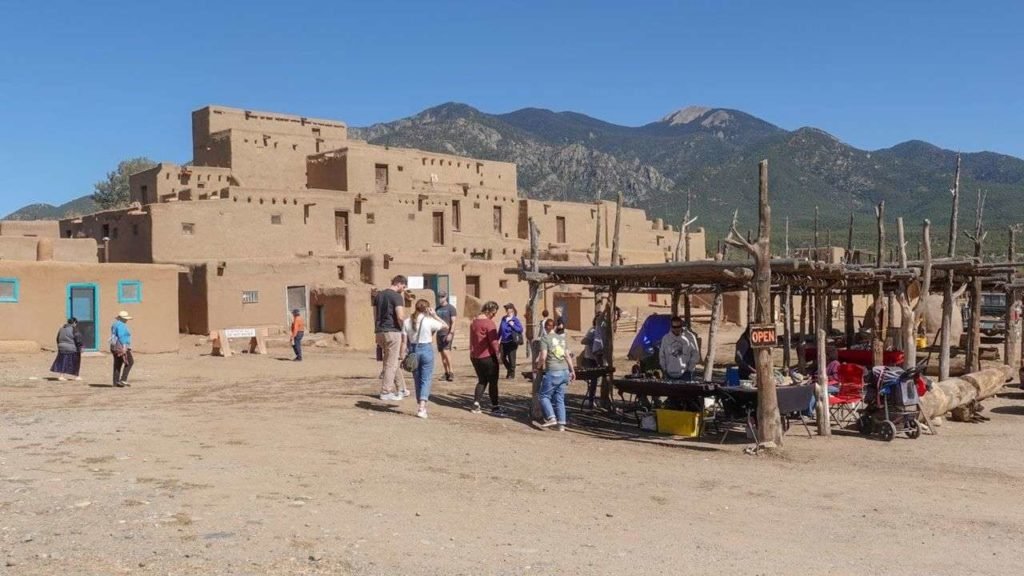
Meet the people of Taos Pueblo, an adobe-walled village about a mile northeast of Taos, New Mexico. About 150 people live here without electricity, running water or indoor plumbing as their ancestors have for centuries. They claim an aboriginal presence in the Taos Valley of the Southwestern United States since time immemorial and guard their culture today.
We visited Taos Pueblo which is recognized by UNESCO as it has been continuously inhabited and maintained by traditional methods since construction. The multi-storied adobe buildings at the village’s heart are estimated to have been built between 1000 and 1450 CE.
Although regarded as one of the most private, secretive and conservative communities, the pueblo is open to the public. Visitors can join a group tour of the village led by a member of the Taos community who will provide insight into their history and traditions.
Their history is oral, sacred and guarded vigorously by them. They continue to practice their own religious beliefs and do not share details with people outside their community.
Many tribe members have modern homes, on reservation land, outside the walled village, always returning to the village for social and cultural celebrations.
Our visit to Taos Pueblo was a fascinating encounter with people who live very much as their ancestors have for hundreds of years.

Cultural tourism has a positive impact on the economy and social life of the people if done responsibly. A traveller can engage with and understand the history, culture and lifestyle of the local people and place they are visiting.
However, travellers go overboard and become too inquisitive while documenting certain tribes and traditions. We often fail to respect the privacy of the people. I would always suggest asking before you take pictures and also take permission from the people before you decide to put them online. Also, it is always better to take a local guide with you when you are visiting any unknown and remote place.
Disclaimer: This blog is written for purely gaining knowledge and in no way supports the advertising of tribes and people. I am sure all of us are responsible here and we will be able to achieve the fine balance between documentation and intrusion.
Pin this for a later read!


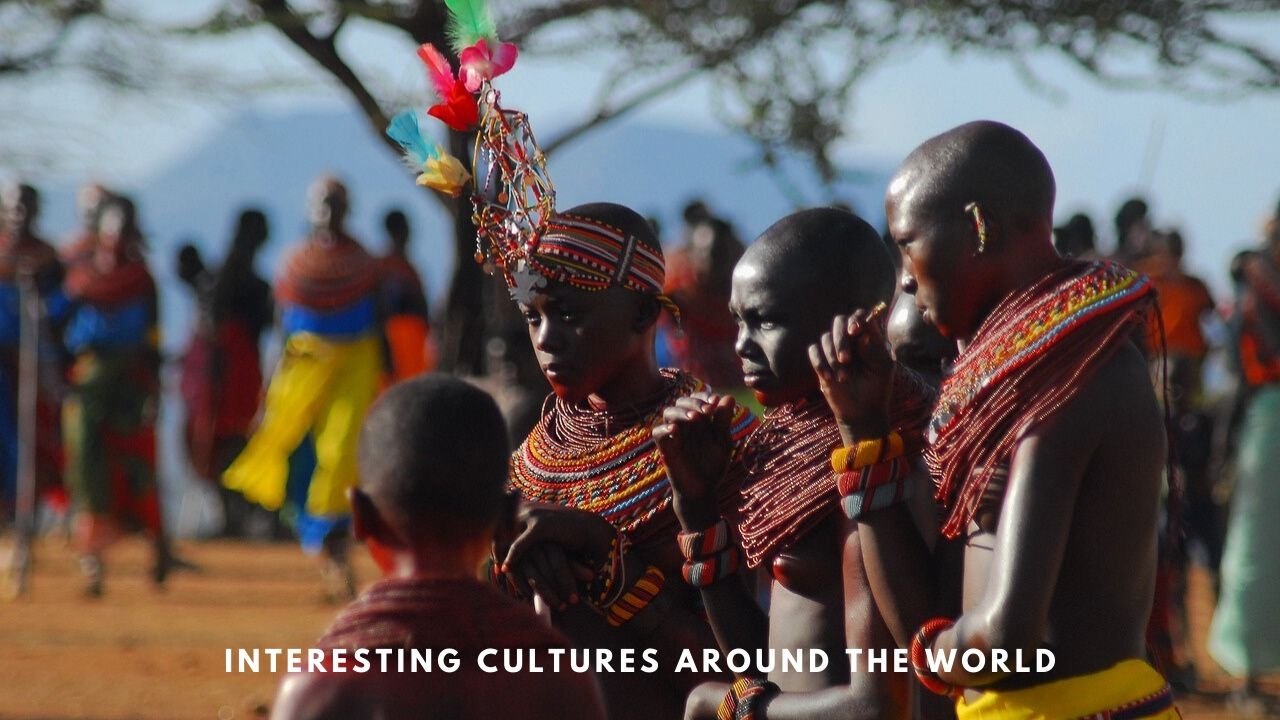
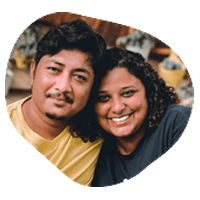
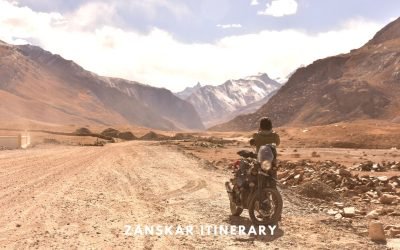
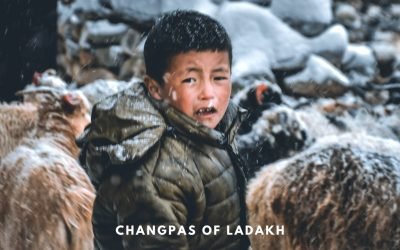
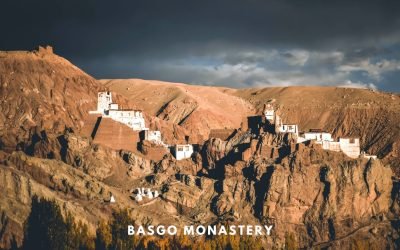
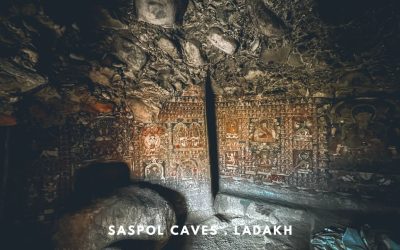
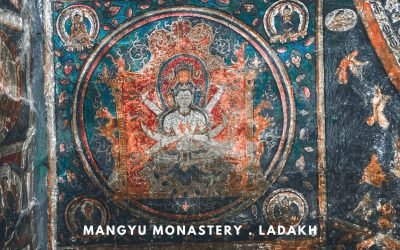
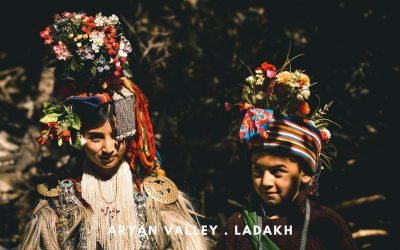
Your article helped me so much in ways to find a culture I am not familiar with for my college course. I enjoyed researching about the Konyak Tribe. I found their traditions and Culture very interesting. I am also Native and understand the colonization amongst the native tribes. I’m Diné from the Navajo Reservation.
Thank you so much! We are glad that our article piqued your interest.
I was doing some reading on the Masaai Tribe and the local government’s attempts in 2022 to force them off their ancestral land to build luxury amenities for the elite and somehow stumbled upon this article. I am so glad I did! This is a great compilation. Kudos to the contributors.
Wow, I thoroughly enjoyed reading about the unique and interesting cultures from around the world! It’s amazing how diverse our planet is and how each culture has its own distinct customs, traditions, and ways of life. From the colourful festivals of India to the intricate tea ceremonies of Japan, every culture has something fascinating to offer. The blog post was well-written and informative, shedding light on lesser-known cultures and their rich heritage. It’s a beautiful reminder of the richness and beauty of our world’s diversity. Great job!”
It was a great trip, a very good cultural research, I am waiting for the continuation of your articles.
Nice post
oh thank you for Toraja culture put on the list. I am indonesia people. very happy to know that Toraja culture is one of 25 interesting culture around the world.
Thank you so much!
Such a very well written post you share here valuable information you will be share with us, it’s really helpful for me.
Thank you!
Many lovely vistas may be found in the Chitral Valley. The Chitral Valley in Pakistan is stunning, and it’s a great place to unwind after a trip to the country. Summer brings the melting of the snow, the flowing of the river, lusher scenery, and a more romantic and attractive environment. In addition, the climate in Chitral is quite pleasant. We have very attractive and reliable Chitral and Kalash Tour Packages. So book your trip now.
In our chitral and kalash tour packages, you’ll have the most relaxed 5 days of your life. We’ll take the Sawat highway from Islamabad and stop in the Upper and Lower Dir Valleys first. We would make you settle at Chitral Inn Hotel after your lunch at Tehzeeb Hotel Dir and a little tea break in between Lowari Pass and Chitral Valley.
The following day, we’ll take you to the Chitral Museum, Shahi Masjid, and Chitral Bazaar, where you can shop if you like. Then would head back to the hotel for a spectacular bonfire.
We’d also visit Bumburet Valley with a local guide, where we would see the local Kalasha Festival ceremonies and explore traditional Kalash homes.
Finally, our chitral and kalash tour package also includes Garam Chashma, a little Chitral Gol National Park sightseeing that will change the way you think of Chitral.
So, pack your bags and book your next trip with us.
It’s actually a great and helpful piece of info.
I’m glad that you simply shared this helpful information with us.
Please keep us up to date like this. Thanks for sharing.
Thank you so much!
Thank you for such a wonderful compilation. Trying to understand the cultures, traditions and history of various etenticities is waht I love when I travel. Posts like this motivate you to travel more and more and learn more. Thanks for sharing
Thank you Parveen!
This is such an amazing blog. You have collected so much information with collaboration with other travelers that it is simply mind blowing. Lovely reading about all the world cultures and different traditions.
Thank you Anshul!
One of the many reasons why I am traveling is to meet people from other cultures and I am fascinated by ordinary people in other countries. Your article is real interesting and I find it fascinating that you have met all these different cultures. I have only been at the Taos Pueblo many years ago.
Thanks Rudy!
Thank you for sharing these many different cultures around the world, and I bet this is only a summarized list. I like the fact that these travelers met these people, and shares their stories with us. People are different, and what makes them have in common is the attitude of being proud of their genuine cultures.
That’s so rightly said, Blair. I guess we are all proud of our heritage and culture and knowledge about our traditions is also a way to appreciate them.
Learning about different cultures is absolutely my favorite thing about traveling. It is endlessly interesting to learn about how different people live and their beliefs and traditions all over the world. The thing that always strikes me is that despite the differences, we always have so much still in common.
That is so true, Sophie. Thanks for sharing your thoughts.
This is such lovely Compilation. Loved reading different tribes from around the world. I have only heard about Nyshi tribe, Head hunters and Khasi people of India. The tribes from Africa and reading about their culture is so fascinating, especially Masai tribe who are still maintaining their culture! I want to visit Peru and Mexico next year. The Quechua people of Perú and their traditional colorful attire attracts me more! Glad to read this Post.
Thank you Mayuri!
I agree with you that yes, travelling allows us to learn more about other cultures and the experience is just amazing.
Thank you for sharing about your learnings on the different cultures around the world. I have always been curious about Tibetan culture and thus, I am happy that you included it in your post.
Tibetan culture is something that interests me a lot. Thanks for sharing your thoughts, Clarice.
Such an interesting read and so fascinating to learn about the varied culture of the world. I have experienced some of the tribes in North East but Arunachal is still in my bucket list. The Red Fanta bottle with straws being offered to God is so amusing.
Thank you Subhashish. I had wanted to include the Apatani tribes from Arunachal also, but it was getting quite a long article. May be in the next one…
This is such an interesting read! Learning about different cultures and how they vary is always one of my favorite things to do. I found the red fanta that is offered to the gods very interesting! I would think the same thing as you if I saw a soda bottle sitting out like that, but it is very interesting what it represents to them. So unique!
Thank you Melissa for sharing your thoughts. Yes, the Red Fanta one is quite interesting!
This was really beautiful and educational article. I have never heard of more than half of the cultures on this list. When we traveled in Asia with a friend of mine we spent a couple of days with Black Hmong women and I loved that whole experience. I would love to explore more of different traditional cultures while traveling. But I also think that it must be a thin line in between opening up for tourists and keeping the authenticity.
Thank you Radka!
It was a great read. Although I have to point out the photo used for the Black Mong are actually a White Hmong subgroup of the Flower Hmong. Although similar they are quite different in clothing styles or Tsoos Tsho. But I loved the article.
Thank you for the correction. I will try to rectify it.
Very interesting topic to cover, like you we also appreciate the opportunity to learn about different cultures when we travel. We spent a night in a small Akha village in the northern mountains of Thailand, a few hundred metres from the border with Burma. We really appreciated learning about the food and spiritual beliefs and many other aspects of life. We also talked about how important to hold on to tradition at the same time as modernising life and quality of life.
I am sure you had a great time with the Akha tribe. Would love to know about your experience there.
Nice that you have Rungus from my home state in your list ! I learned of Meghalaya recently, and today it is interesting I learned that property is passed down to the youngest daughter ! I’m familiar with most of the Asian tribes you mentioned. I want to learn more about the African tribes you shared here ! =)
Thanks Jeremy! I found the Rungus tribe quite fascinating and hope to visit there again!
The cultures of the world are so colourful and diverse and yet there is a thread that binds them together. This is a fascinating post that provides glimpses of culture across the world. Though exposed to only a few of the cultures here, I can appreciate the beauty of each one of them. What is really interesting is that somewhere deep down there are similar threads in the cultures, for example, some customs between tribes in the North East of India are similar to those found in some tribes of Sabah.
Yes, I remember visiting the Mari Mari cultural village where one of the tribes were similar to the Konyak tribes of Nagaland. Thank you for sharing your views here.
What a fascinating variety i the cultures shown around the world. When we think we travelled a lot, I read a blog post like this and know we still have so much to see. It is great to see that so many bloggers have spent time really getting to know different cultures. And they really caught some amazing photos and faces!
However much we travel, I think we cannot see enough! Thanks, Linda, for sharing your thoughts.
As I read this post I realized I have not stepped out of my comfort zone when I travel. I stay in America, Canada, Europe – all very similar. This is in large due to the distance to India or China but also lack of my comfort. I believe I am due to take a big jump and explore Morocco’s Berber communities
That you are travelling itself proves you are out of your comfort zone. Hope you explore more!
Love this post 🙂 I was so intrigued by the Masai tribe too whilst in Mara.
Thanks Jyotsna!
Wow this is so cool. I love this. When I traveled in India few months ago I met different tribes too. I definitely want to travel in Nagaland to meet some of the amazing tribes. I did learn about Quechua tribe when I went to Machu Picchu and such interesting stories.
Thank you, Raksha!
Its such a unique and captivating compilation. Glad to be a part of it!
Thank you Neha! Your contribution on offering Red Fanta to the Gods is quite interesting! 🙂